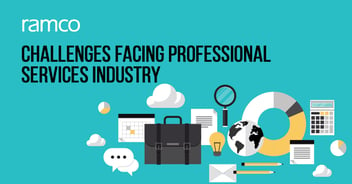
All eyes and ears stood frozen on him. It was the penalty round. This way or that way, he debated in his mind. One wrong stroke would mean the next player will decide the fate. But one right stroke would mean his team would snatch the trophy, right there.
As Joe Smith watched a nail-biting Football face-off, his brain forked into a play-off too. As the CIO of a leading IT Services company, he was torn in a tug-of-war for the last two days.
He had been caught hopelessly between Mr. Devil and Mr. Right.
On one shoulder, the wicked guy with horns laid relaxed crossing one knee above another and kicking him every now and then with a ‘How does it matter’.
‘How does it matter if invoicing stays complex and your company misses some margins or revenue opportunities? How does it matter if the client follows a different billing format? How does it matter if you are not following what this country’s tax system asks you to? How does it matter if you cannot trace resource costs to projects, contracts and to the level of employees as accurately as you may wish?” He would tease and cajole him.
In fact his laziness and indifference was so stubborn that Smith would have given up already had it not been to the white-satin-draped guy who tip-toed every now and then on his other shoulder.
The guy with a halo over his head would shake his conscience. “It matters. Don’t you see how ridiculously you are missing revenue leaks on every contract and how both you and your clients are living in a maze when it comes to expense management and project tracking? The irony of it is too much – you folks automate everything for your clients and yet here you are – caught up in stupid data redundancies and invoicing nightmares! All this, when you can very well opt for an SRP.”
Smith’s conscience pricked him more. It was true.
For the last two quarters he had felt it without doubt that the project management scenario was going awry as the company’s old system struggled with visibility of resources and hence conked off when it came to precise forecasting of resource requirements or timely contract renewal and in fact, even on, resource utilization rates.
The last meeting one of his clients abroad had bluntly pointed that the company could not accommodate the variety of invoice formats - fixed bid, fixed monthly, slab based, role based, employee specific rates etc. He couldn’t help but worry how their ERP would juggle all those multi-country, multi-location, multi-regulatory-environment challenges that will soon scale up. At the same meeting, incidentally, his star project manager had thrown his hands up citing how he could not manage the animal the ERP was, whenever he needed a tab on the right person for the right place at the right time. As to his sales team, complaints here were a rule rather than an exception, often pointing out that fixed bid projects have been losing margin. All thanks to inability of systems to track the estimated efforts against the actual with errors around timeline and delivery milestone’s status.
He also knew that specialized stand-alone solutions were good options but he needed something that was seamless with 360 degree flavor, would not compromise specific functionalities and would yet offer an end-to-end bundle. He had also heard experts pointing out how organic, well-rounded, soup-to-nuts SRPs with core release cycles were distinct from incomplete SRPs that had layers patched in through acquisitions or with hard-to-handle configurations.
The time to decide was now – dare to migrate to the right SRP or comfortably continue with makeshift choices? As he wavered between the two shoulder taps, he heard a deafening applause on TV – the player had just scored a winning goal with an unprecedented kick. He had changed the game.
Frequently Asked Questions (FAQs)
Enterprise asset management (EAM) involves the management of mission critical assets of an organization throughout each asset's lifecycle. EAM is used to plan, optimize, execute, and track the needed maintenance activities with the associated priorities, skills, materials, tools, and information. The aim is to optimize the quality and utilization of assets throughout their lifecycle, increase productive uptime and reduce operational costs.
Enterprise asset management (EAM) involves the management of the maintenance of physical assets of an organization throughout each asset's lifecycle. EAM is used to plan, optimize, execute, and track the needed maintenance activities with the associated priorities, skills, materials, tools, and information.
The software helps in effective maintenance of assets through preventive, predictive, shutdown and breakdown maintenance strategies. The system also helps enterprises mitigate equipment risks by enhanced safety standards. The streamlined operations and improved asset performance helps organizations increase their investment effectiveness.
EAM is important because it helps organizations track, assess, manage and optimize asset quality and reliability. Asset intensive Organizations have hundreds, thousands, even millions of assets which needs to be maintained to maximize / optimize life of these assets to increase the return on investment.
The key features of effective EAM are:
- Work management.
- Maintenance Strategies (Preventive/ Predictive / Breakdown / Shutdown).
- Planning and scheduling.
- Supply chain management.
- Health and safety.
- Mobility.
- Analytics.
- Improved Asset Health at reduced cost through data driven maintenance Programs
- Complete visibilityon entire maintenance data across Equipment, across Models, across Branches to aid in analysis & decision making such as to Repair or Replace the Equipment
- Insightful analysis of Inspection Data to improve customer satisfaction
- Effective maintenance management enhanced by predictive maintenance and inbuilt analytics
- Increased reliability and safety, keeps complete track of all the inspections & calibration schedules
- Mobile Application enables users to execute work while “in the field” leading to minimized non-productive time and increased productivity and reduces duplication of work and human errors in recording information.
- Quick turnaround time through Actionable Notification & Alerts for every process in real time and accessible anytime and anywhere.
- Improved Regulatory Part of asset management involves the implementation of better O&M practices, which can significantly improve compliance.
Asset Intensive companies under the following Industries :
- Ports
- Cement and Mining
- Utilities
- Fleet Maintenance
- Equipment Rental
- Other Manufacturing
- Real Estate & Infrastructure
- Power Generation
Contact us for a meeting and schedule a demo
This differs on case to case basis, based on the type of installation and unique industry specific requirements. Contact us for a meeting and schedule a demo.
This differs on case to case basis, based on the type of installation and unique industry specific requirements. Contact us for a meeting and schedule a demo.
Stay Connected, follow us on LinkedIn / Twitter to know more about EAM Software latest trends.


